The Power of Agile Leadership in an Era of Disruption


Leading people is not about transactions. Leading people is about transformation.
The question isn’t whether disruption will hit your industry, but when and how hard. Companies are facing unprecedented levels of competition, technological advancements, and economic shifts that challenge every leader. According to Aon’s 2023 Global Risk Management Survey, 41% of companies have experienced losses due to increasing competition, yet only 51% have plans in place to address these risks. This stark reality underscores the need for leadership that is both resilient and responsive.
Agile leadership is a necessity for leaders looking to stay competitive, foster innovation, and build resilient teams in an era marked by constant disruption. By embracing agile leadership, leaders can remain flexible and proactive in the face of change—helping them achieve sustained success in an unpredictable environment. Let’s explore the concept of agile leadership, how it empowers leaders and teams alike, and why it is essential for organizational growth, innovation, and resilience.
What is Agile Leadership?
Key Takeaway:
Agile leadership is a leadership focus that starts with a mindset of adaptability, collaboration, and continuous improvement. Agile leaders prioritize empowering teams, fostering innovation, and responding quickly to change. By embodying key traits such as integrity, visionary thinking, collaboration, and a growth mindset, agile leaders drive organizational growth, support team development, and create a culture of innovation that thrives in an ever-evolving business landscape.
At its core, agile leadership is about adaptability. When faced with disruptions—whether they’re economic, technological, or market-related—agile leaders quickly reassess their strategies, empower their teams to take action, and adapt their approaches to ensure continued progress and success.
Agile leadership involves leading in a way that increases organizational agility and allows leaders to pivot quickly in response to changing circumstances, making it possible to remain resilient in the face of disruption. Unlike the Agile methodology often associated with software development, agile leadership refers to a mindset and set of practices that prioritize flexibility, collaboration, and continual improvement.
Agile leaders assess situations rapidly, adjust strategies when necessary, and empower their teams to act with autonomy. This approach fosters a sense of ownership and accountability within teams, as individuals are trusted to make decisions that contribute to the organization’s success. Importantly, agile leadership creates a culture of continuous learning and iterative progress, ensuring that feedback is actively sought and used to drive improvements.
Take the first step toward solving the leadership crisis in a disruptive world when you download our free guide, Where Are All the Great Leaders?
The Importance of Agile Leadership in Today’s Business Landscape
In a world defined by disruption and uncertainty, agile leadership is more important than ever. The constant pace of technological change, the unpredictability of global markets, and the pressure of emerging competition require organizations to rapidly evolve and adapt. Some 71% of organizations are reportedly utilizing agile practices to increase adaptability, and agile leadership enables organizations to thrive by helping them to respond swiftly to external disruptions, navigate economic shifts, and embrace technological advancements. Here’s how:
Thriving in Uncertainty
The modern business world is defined by volatility. Economic shifts, technological breakthroughs, and global events can change the landscape in an instant. Agile leadership helps organizations stay responsive in the face of this uncertainty. Agile leaders are not paralyzed by disruption; instead, they view change as an opportunity for growth. They are equipped to make quick decisions, pivot strategies, and guide their teams through challenging times.
By encouraging teams to embrace flexibility, agile leadership fosters an organizational culture where quick, effective responses to disruption are the norm. This helps organizations navigate uncertainty with confidence, increasing their likelihood of not only surviving but also thriving through challenging times.
Fostering Innovation and Adaptability
In an era of rapid change, innovation is the lifeblood of business success. Agile leadership creates the conditions necessary for innovation to thrive by encouraging experimentation and adaptability. Leaders who prioritize agility empower their teams to test new ideas, learn from failure, and continuously improve processes and products.
Agile leaders promote a culture of innovation by supporting risk-taking, providing resources for experimentation, and fostering an environment where new ideas can flourish. This flexibility enables organizations to stay ahead of the curve, creating opportunities to lead in their industries rather than simply react to trends.
Building Resilient Teams
Agile leadership is crucial to building a resilient culture with teams that can perform under pressure. In times of disruption, teams need to be adaptable, accountable, and autonomous to respond to challenges effectively. Agile leadership fosters these qualities by entrusting teams with appropriate decision-making power and providing the support needed for them to succeed.
Resilient teams, empowered by agile leadership, can overcome setbacks, adapt to evolving conditions, and move forward with confidence. When teams feel trusted to make decisions and supported by strong leadership, they become
Agile Leadership in Action
Frito-Lay serves as an excellent example of agile leadership in action. Amid an economic recession, unprecedented inflation, and unpredictable weather conditions that disrupted their supply chain, Frito-Lay realized they needed to adapt—quickly.
By promoting a culture that encourages experimentation and rapid pivots to meet consumer preferences, Frito-Lay has remained at the forefront of innovation in the food and snack industry. Agile leadership allowed the company to be more responsive to market demands, giving teams the autonomy to explore new ideas and strategies. This empowered Frito-Lay to launch breakthrough products that not only met consumer needs but also set new trends in the marketplace. Teams were empowered to make decisions in real time, responding quickly to disruptions and driving innovation that kept the company competitive.
This highlights how agile leadership fosters a culture where teams are empowered to act decisively and innovate continually. By shifting from traditional leadership models to a more agile approach, Frito-Lay created an environment where adaptability and innovation went hand-in-hand, enabling them to thrive in a fast-changing industry.
Key Traits of an Agile Leader
Agile leadership is not about adhering to a specific process or methodology. Instead, agile leadership involves embodying certain key traits that enable leaders to respond effectively to change. Here are some of the most important traits of an agile leader:
Integrity and Accountability
At the heart of agile leadership is integrity—an unwavering commitment to ethical principles and transparency. Agile leaders lead by example, setting high standards for themselves and their teams. They make decisions with honesty and act consistently, even in difficult situations. This inspires trust within teams and encourages a sense of mutual respect, creating a culture of integrity that transcends individual actions and becomes embedded in the organization’s values.
Accountability is equally crucial for building trust and demonstrating integrity. Agile leaders take full responsibility for their actions—both successes and setbacks. They do not shift blame when challenges arise but instead model accountability at all levels. When leaders hold themselves responsible for outcomes, they inspire teams to do the same, fostering a strong sense of ownership and collaboration across the organization. The result: A higher level of engagement, stronger decision-making, and improved team dynamics.
Visionary Thinking and Strategic Alignment

A plan gives both leaders and teams a path forward in times of change.
Agile leadership requires leaders to maintain a visionary mindset, always thinking ahead and staying attuned to potential future shifts. They take a proactive approach, rather than a reactive one, to focus on what’s in their control rather than external conditions they can’t influence. Agile leaders must have a clear vision that aligns with the broader mission and values of the organization. This vision should not be static; instead, it should evolve and adapt as new opportunities and challenges arise. The ability to pivot and adjust the organizational vision in response to external forces is what sets agile leaders apart.
To execute their vision effectively, leaders must also focus on strategic alignment. It’s important that every decision, initiative, and project is aligned with the organization’s overarching goals. Agile leaders constantly ensure that team efforts are in sync with the company’s strategic direction, maintaining a balance between short-term needs and long-term objectives. In times of disruption, agility requires visionary leaders to both inspire and align teams toward a clear, shared purpose.
Collaboration
Collaboration is a cornerstone of agile leadership. Agile leaders understand that success is rarely achieved in isolation and actively leverage the collective intelligence of their teams. By fostering an environment of openness and mutual respect, they encourage cross-functional teamwork, knowledge sharing, and creative problem-solving. This collaborative approach empowers everyone’s unique ideas and skills to flourish.
A key aspect of collaboration is recognizing potential in others. Agile leaders see beyond current capabilities, identifying opportunities for growth and development. Through coaching and mentorship, they support team members in unlocking their full potential, building capability, and enhancing engagement. By offering guidance, constructive feedback, and opportunities for skill development, leaders help individuals rise to new challenges and contribute their best work.
This focus on growth strengthens collaboration by building trust and ownership. When leaders invest in their people’s development and break down silos, they create a culture where everyone feels empowered to contribute to the team’s success, especially during times of disruption. As teams become more capable and engaged, the ability to adapt and innovate increases, driving stronger results and resilience.
Growth Mindset
Agile leaders must maintain a growth mindset, which involves staying open to new information and embracing change. Leaders with a growth mindset actively seek out opportunities for their own personal and professional development, knowing that their ability to evolve as leaders is essential to the success of their teams. This willingness to continuously improve and adapt is a hallmark of agile leadership and is crucial for navigating the complexities of today’s business environment.
Agile leaders with a growth mindset also foster this mentality within their teams. By encouraging team members to take risks, learn from mistakes, and continually strive to improve, agile leaders create an environment where experimentation and innovation thrive. This leads to greater adaptability and resilience when faced with challenges.
How to Develop Agile Leadership
While some leaders may naturally embody the traits of agility, anyone can develop the skills and mindset necessary to lead effectively in times of change. Here are several strategies for cultivating agile leadership:
Develop a Leader’s Mindset
Agile leadership begins with developing a mindset of self-leadership. Leaders must take ownership of their personal growth and practice adaptability in every aspect of their work. This shift from fixed thinking to a growth-oriented leadership approach helps leaders remain open to new ideas, challenges, and opportunities.
By leading by example, agile leaders set the tone for their teams, demonstrating that change is not something to fear but something to embrace. They encourage a culture of continuous improvement, where learning and adaptation are integral to success.
Download our guide, Crucial Insights for First-Level Leaders, to empower your new and transitioning leaders to create high-performing teams during periods of disruption.
Hold Regular 1-on-1s
Regular 1-on-1 meetings are a powerful tool for developing agile leadership skills. These meetings not only provide space for leaders to address their employees’ concerns but also give them valuable insight into how teams are navigating change and disruption. By staying connected with team members on an individual level, leaders gain a deeper understanding of potential issues before they escalate into bigger problems. This ongoing communication allows leaders to make more informed decisions, fostering a proactive approach to challenges.
Moreover, 1-on-1s offer leaders the opportunity to coach their team members, helping them develop their skills and grow in their roles. Through personalized feedback and guidance, agile leaders can nurture talent and support their employees’ professional growth, ensuring that individuals feel valued and empowered. These regular check-ins create alignment between leaders and team members, reinforcing shared goals and accountability while maintaining focus on achieving results, even during times of disruption.
Ensure you and your team members get the most out of your meetings when you download our free guide, 100+ Questions for Better 1-on-1s With Your Direct Reports.
Set Up Your Team to Get Results
Agile leaders must clearly define what success looks like while giving teams the autonomy to decide how to achieve it. By setting clear goals and promoting an understanding of how individual efforts contribute to the larger organizational mission, agile leaders create an environment where teams feel empowered to take ownership of their work.
Agile leadership ensures that execution is anchored to outcomes, providing teams with the flexibility to find the best path forward while remaining aligned with the organization’s overarching objectives.
Help your teams execute on top priorities, even as the landscape continues to shift, with our guide: Mobilize Your Team to Deliver Breakthrough Results.
Create a Culture of Feedback
Feedback is a cornerstone of agile leadership. Frequent, forward-focused feedback accelerates learning and promotes an iterative mindset, which is central to agility. Agile leaders encourage open dialogue, helping their teams continuously improve by providing constructive feedback that drives performance.
Creating a culture where feedback is valued and acted upon fosters an environment where innovation can flourish. Teams are not just reacting to changes—they are proactively improving and adapting, leading to better results over time.
Learn the importance of trust, accountability, feedback, and change management for disruption-proof teams in our guide, The 4 Pillars of a Thriving Workplace Culture.
Lead Your Team Through Change

We can only graduate to leading people through change if we know how to deal with change as humans first.
Change is inevitable, but how leaders guide their teams through it can make all the difference. Agile leaders are also change leaders, equipped to lead their teams through the stages of disruption and transformation. The Change Model below provides a practical framework for understanding team reactions to change, guiding leaders through each stage:

- Status Quo: Establish a clear vision and purpose to help teams maintain stability during the initial phase of change.
- Disruption: Provide support and guidance as teams experience uncertainty, helping them reframe challenges as opportunities.
- Adoption: Encourage new behaviors and mindsets, helping teams integrate change into their everyday practices.
- Innovation: Foster a culture of continuous improvement, where teams are empowered to find innovative solutions and lead the way forward.
Discover the biggest changes facing today’s organizations and how leaders can effectively guide their teams through disruption in our guide, The Energy of Change: 5 Leadership Behaviors to Drive Collective Action in a Fluid Landscape.
Manage Your Time and Energy Effectively
Time management is key to maintaining agility. Leaders who become bogged down with urgent-yet-unimportant tasks may lose sight of the greater goal. When leaders know how to effectively prioritize—exemplified in Habit 3: Put First Things First® in the 7 Habits of Highly Effective People®—they can protect the time and energy needed to accomplish the most crucial tasks and avoid becoming overwhelmed with distractions and time-wasters.
While crises and unforeseen events may occur more frequently during times of disruption, agile leaders should aim to spend most of their time in Quadrant 2, as outlined in the image of The 4 Quadrants of Time Management below:

Agile leaders must also prioritize effective use of their energy. The 5 Energy Drivers—sleep, relaxation, nutrition, exercise, and connection—can help leaders maintain the energy necessary to lead effectively through periods of disruption.
Managing energy is just as important as managing time. Agile leaders who take care of their well-being are better equipped to lead with clarity and resilience, ensuring they remain effective in the face of change.
Prioritize self-renewal during disruption when you download our free guide, Manage Your Energy to Do Your Job Well.
The Most Trusted Leadership Company
Learn how your organization can use our people, content, and technology to create collective action and meaningful change.

Overcoming Common Challenges in Agile Leadership
While agile leadership offers many benefits, it is not without its challenges. Implementing agility within an organization has several potential obstacles. Below, we’ll explore some of the common challenges that agile leaders may encounter and provide strategies for overcoming them.
Resistance to Change
One of the most significant challenges in adopting agile leadership is resistance to change. Both leaders and employees may struggle with shifting from traditional ways of working to a more flexible, collaborative, and proactive model.
For leaders, especially those who have been entrenched in established methods, resistance often comes from discomfort with relinquishing control. Agile leadership requires leaders to move from directing all decisions to a more adaptive, facilitative role that enables team autonomy and collaboration.
Employees, on the other hand, may resist due to uncertainty and fear. Agile leadership demands more independence, adaptability, and constant change—values that can be intimidating for those accustomed to clear instructions and predictable workflows.
To overcome this, agile leaders must clearly communicate the rationale behind the shift. By explaining the benefits, such as increased responsiveness and empowerment, they can address concerns and help both leaders and employees embrace the change in question. Leaders should also involve their teams in the process, encourage feedback, and demonstrate that their input is valued. This involvement makes the transition smoother and helps employees feel more confident in navigating change.
Additionally, leaders must model the behaviors they want to see. By embracing agility themselves—such as being open to learning, adapting, and collaborating—leaders can inspire their teams to follow suit. Acknowledging struggles during the transition can also create a more supportive environment.
Maintaining Balance Between Autonomy and Control
One of the core tenets of agile leadership is giving teams the autonomy to make decisions. However, this must be balanced with the need to ensure alignment with organizational goals and standards. Agile leaders have to strike the right balance between providing guidance and granting autonomy, ensuring that teams remain focused on shared objectives while taking ownership of their work.
To address this challenge, agile leaders must set clear expectations. Leaders need to establish a shared understanding of the organization’s vision, goals, and values while empowering teams to determine how to achieve those objectives. Providing execution frameworks or guidelines within which teams can operate gives them the freedom to make decisions autonomously but within a coherent structure that aligns with the larger strategy.
Moreover, ongoing coaching and mentorship are essential. Leaders should regularly check in with teams to ensure they are on track, offer guidance when needed, and adjust the course if necessary. This balance of trust and support creates an environment where teams can thrive while staying aligned with the organization’s mission.
Aligning Teams Around a Common Purpose
During times of change, communication barriers and misalignment can significantly disrupt progress. As teams become more decentralized, either through geographical distance, changing roles, or shifting priorities, it becomes increasingly difficult to keep everyone aligned toward a common purpose. Agile leaders must work proactively to address these challenges by ensuring that the organization’s objectives remain clear and that teams stay motivated and focused on shared goals.
Agile leaders should emphasize shared accountability. Leaders can create cross-functional teams or task forces with collective ownership of outcomes to prevent silos. These outcomes should focus on the few Wildly Important Goals® that will have the greatest impact on the organization. When individuals understand that they are part of a greater, interconnected cause, it fosters a stronger sense of commitment to the organization’s success.
During periods of disruption or change, leaders should focus on reinforcing the “why” behind the work, helping teams see the purpose of what they are doing, even when day-to-day tasks become challenging.
Thrive Through Disruption with Agile Leadership
Agile leadership equips organizations to navigate change, foster innovation, and build resilient teams. By emphasizing adaptability, accountability, and autonomy, agile leaders can drive success in a rapidly changing world. Organizations that embrace agile leadership will be better positioned to thrive through disruption, turning uncertainty into opportunity.
Leveraging disruption is not just a goal—it’s a mindset that agile leaders cultivate in their teams, enabling them to adapt, innovate, and succeed no matter what challenges lie ahead. Discover your Positive Disruptor Profile and learn how your leaders can thrive with agility during disruptive times.








